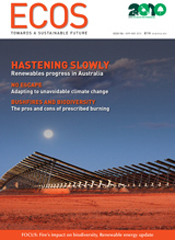
|
From This Issue

Sending water south not a simple proposition
Managing fire's impact on biodiversity
Winds open window onto the deep sea
Handfishes: thylacines of the sea?
Supporting rainforest biodiversity in a changing climate
Mapping native vegetation loss in the Wet Tropics
Hastening slowly in the global renewables race
Methane reductions needed urgently
Change a constant for Australian rice growers
Preparing to adapt to unavoidable climate change
Environmental monitoring gets 'standard gauge' solution
Blogging on climate change – a job for the brave
A leading climate scientist writes for the people
Events Calendar
A new challenge for the clean energy sector
The challenges of sharing scientific knowledge
Wild man's dedication led environmental publishing
ECOS Archive
Welcome to the ECOS Archive site which brings together 40 years of sustainability articles from 1974-2014.
For more recent ECOS articles visit the blog. You can also sign up to the email alert or RSS feed


